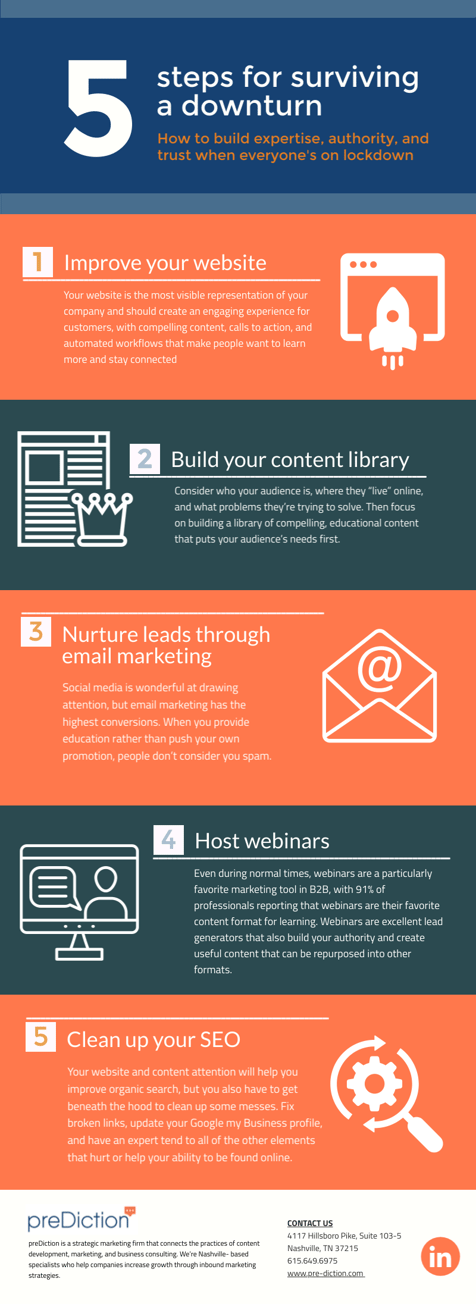
The coronavirus pandemic presents intense challenges to business leaders as they work to protect their companies.
Amidst extraordinary circumstances, it’s easy to forget that this downturn will end the way that all do: with a recovery.
A Harvard Business Review study on how companies react to recessions found that 9% of businesses come out of a recession stronger than ever by cutting costs associated with operating efficiency while spending more than rivals on marketing, R&D, and assets. Conversely, the study found that short-term reactive decisions can imperil a company’s ability to survive both now and after the recovery comes.
The year-long study, titled “Roaring out of Recession,” found that companies falling into three categories fail to survive or flourish after a recession ends: those that only cut costs heavily during a downturn (“prevention”), those that only invest more than rivals during a recession (“promotion”), and those that have a haphazard combination of both prevention and promotion, with an over-emphasis on reducing employees (“pragmatic.”)
HBR classifies the winning category of companies as “progressive,” those that get the prevention-promotion balance right, helping them tackle short-term problems and create a successful medium-term strategy. The companies that create efficiencies to survive today while investing to grow tomorrow – including judiciously increasing spending on marketing and R&D – are the ones that do well after a recession. The benefits may only appear modest during the downturn, but translate into a substantial advantage in sales and profits afterward.
A separate study by Bain noted that when companies react by slashing all costs and scaling back marketing, they suffer later when they have to spend more than they saved to regain visibility. In fact, Bain found that those companies have the lowest probability of pulling ahead of competitors when the economy improves. The companies that do well manage a strong defense and offense simultaneously, reining in costs while reinvesting in growth.
Digital Marketing Just Became More Essential
Collectively, our lives just went from being highly digital to almost completely virtual. Companies that have lagged in digital marketing are suddenly being forced to quickly catch up on top of adapting myriad aspects of their standard business operations to the new (ab)normal.
Bain’s analysis found that companies wishing to not only survive but capitalize on a recession should look to digital marketing as a key tool in their strategic arsenal. Their study observes that the value of traditional media has long been waning as digital marketing has become more dominant, allowing companies to create more personalized outreach to customers. The customization, automation, and data aggregation of digital marketing gives companies greater reach at scale and deep insights on how messaging, pricing, products, services, and overall branding are received by different market segments.
As noted in a recent Forbes article, corporate reactions to the coronavirus pandemic include a greater investment toward marketing tactics that drive online sales. It’s reasonable to expect a reduction in marketing investments on campaigns to drive short-term sales or business outcomes, while keeping brand-building campaigns live.
Now is not the time to shut down marketing and hide. This crisis demands that your company become even more visible around putting your customers first. This does not mean flooding already-bursting inboxes with empty platitudes or opportunistic drivel. It means providing your audience with valuable, authentic content that builds long-term trust in your brand and positions your company as the leading source of information in your field.
This approach is the essence of inbound marketing, the most successful way to build leads and sales today. Inbound marketing focuses on generating, nurturing, and converting leads by creating and delivering the right content at the right time. It’s the modern approach to marketing, one which attracts and engages customers by putting their needs first. Companies earn trust and visibility by demonstrating their authority around the issues that matter to customers.
Read more: Marketing is Dead. Long Live Inbound Marketing
People gravitate to information that provides genuine value. And when companies offer a steady flow of expert content, search engines reward them with higher rankings in search results and greater online visibility in general.
As leads and sales become more challenging, inbound marketing and SEO are key strategies for both short and long-term survival. With competitors slowing the cadence of their content publishing and SEO efforts, the opportunity and value of these strategies to gain advantage are magnified.
Building Trust When Your Customers Need it Most
Now is the ideal time to focus on inbound marketing. People are glued to their screens and traditional media has stalled, providing companies with a bigger and more captive audience than ever. While others panic and let their foot off the gas, this is your moment to get your digital house in order.
Here are 5 steps that your company can take now to stay strong through the current downturn and thrive after the recovery:
 1. Improve your website
1. Improve your website
Your website is the most visible representation of your business, and far too many companies inexplicably neglect this critical real estate. Now is the time to clean up and strengthen your site, transforming it from a pretty brochure to a lead nurturing machine. Your website should create an engaging experience for customers, with compelling content, calls to action, and automated workflows that make people want to learn more and stay connected.
2. Build your content library
Consider who your audience is, where they “live” online, and what problems they’re trying to solve. Then focus on building a library of compelling, educational content that puts your audience’s needs first. Post content across your website and social media channels, and pitch high-authority guest posting opportunities so that your content expands your reach. Consider diversifying beyond blog content to create other formats that attract your target audience – eBooks, infographics, and videos are great places to start. A steady stream of high-quality content is the fuel for lead nurturing and SEO, as well as an evergreen investment that will continue to pay dividends over time.
3. Nurture leads through email marketing
Social media is wonderful at drawing attention and creating awareness, but you don’t own any of that traffic. Besides, you want people to do more than just “like” you, so social media should be seen as a key but secondary point of connection. Email is the name of the game, with email marketing consistently proven to be the most effective tool at actually converting prospects into customers. When you provide education rather than push your own promotion, people don’t consider you spam. In fact, they look to you for help with their problems. Leverage that terrific content you’re developing to create a regular email marketing cadence that engages your audience, guides them to your website, and gently nurtures them along the sales funnel.
4. Host webinars
Even during normal times, webinars are a particularly favorite marketing tool in B2B, with 91% of professionals reporting that webinars are their favorite content format for learning. Webinars are excellent lead generators that also build your authority and create useful content that can be repurposed into other formats. With everyone locked in their homes right now, webinars are sure to explode in popularity, subbing for all the conferences and meetings that people would normally be attending.
5. Clean up your SEO
Your website and content attention will help you improve organic search, but you also have to get beneath the hood to clean up some messes. Fix broken links, update your Google My Business profile, and have an expert tend to all of the other elements that hurt or help your ability to be found online.
The current crisis presents an opportunity amidst the challenge. After the emergency is behind us, people may end up preferring the increased digital experiences that they adopted during the pandemic, while companies may appreciate the deeper relationship they have with customers as a result of digital tools.
The companies that most successfully weather a downturn are those that stay closely connected to customer needs during the uncertain times. Digital marketing – especially inbound – offers you a strategic and tactical advantage by establishing a close connection with your customers that lasts over time. This connected, customer-focused approach can protect you through a downturn and set you up for lasting success as the recovery begins.
![]()